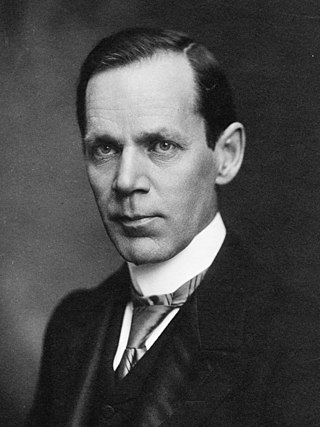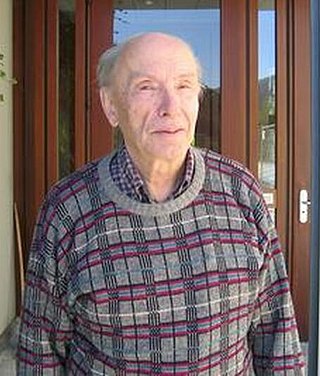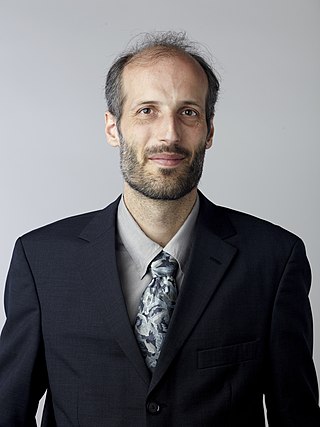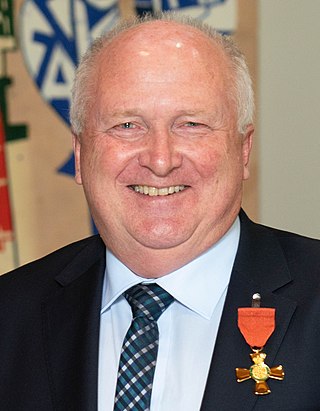
Lars Valerian Ahlfors was a Finnish mathematician, remembered for his work in the field of Riemann surfaces and his textbook on complex analysis.

Paul Julius Oswald Teichmüller was a German mathematician who made contributions to complex analysis. He introduced quasiconformal mappings and differential geometric methods into the study of Riemann surfaces. Teichmüller spaces are named after him.

Richard Cockburn Maclaurin was a Scottish-born U.S. educator and mathematical physicist. He was made president of MIT in 1909, and held the position until his death in 1920.
In mathematical complex analysis, a quasiconformal mapping, introduced by Grötzsch (1928) and named by Ahlfors (1935), is a homeomorphism between plane domains which to first order takes small circles to small ellipses of bounded eccentricity.

Wolfgang M. Schmidt is an Austrian mathematician working in the area of number theory. He studied mathematics at the University of Vienna, where he received his PhD, which was supervised by Edmund Hlawka, in 1955. Wolfgang Schmidt is a Professor Emeritus from the University of Colorado at Boulder and a member of the Austrian Academy of Sciences and the Polish Academy of Sciences.

Henryk Iwaniec is a Polish-American mathematician, and since 1987 a professor at Rutgers University. He is a member of the American Academy of Arts and Sciences and Polish Academy of Sciences. He has made important contributions to analytic and algebraic number theory as well as harmonic analysis. He is the recipient of Cole Prize (2002), Steele Prize (2011), and Shaw Prize (2015).
In mathematics, Liouville's theorem, proved by Joseph Liouville in 1850, is a rigidity theorem about conformal mappings in Euclidean space. It states that every smooth conformal mapping on a domain of Rn, where n > 2, can be expressed as a composition of translations, similarities, orthogonal transformations and inversions: they are Möbius transformations. This theorem severely limits the variety of possible conformal mappings in R3 and higher-dimensional spaces. By contrast, conformal mappings in R2 can be much more complicated – for example, all simply connected planar domains are conformally equivalent, by the Riemann mapping theorem.

Paul Roesel Garabedian was a mathematician and numerical analyst. Garabedian was the Director-Division of Computational Fluid Dynamics at the Courant Institute of Mathematical Sciences, New York University. He is known for his contributions to the fields of computational fluid dynamics and plasma physics, which ranged from elegant existence proofs for potential theory and conformal mappings to the design and optimization of stellarators. Garabedian was elected a member of the National Academy of Sciences in 1975.
In mathematics, the distortion is a measure of the amount by which a function from the Euclidean plane to itself distorts circles to ellipses. If the distortion of a function is equal to one, then it is conformal; if the distortion is bounded and the function is a homeomorphism, then it is quasiconformal. The distortion of a function ƒ of the plane is given by

Sir Martin Hairer is an Austrian-British mathematician working in the field of stochastic analysis, in particular stochastic partial differential equations. He is Professor of Mathematics at EPFL and at Imperial College London. He previously held appointments at the University of Warwick and the Courant Institute of New York University. In 2014 he was awarded the Fields Medal, one of the highest honours a mathematician can achieve. In 2020 he won the 2021 Breakthrough Prize in Mathematics.
In mathematics, the measurable Riemann mapping theorem is a theorem proved in 1960 by Lars Ahlfors and Lipman Bers in complex analysis and geometric function theory. Contrary to its name, it is not a direct generalization of the Riemann mapping theorem, but instead a result concerning quasiconformal mappings and solutions of the Beltrami equation. The result was prefigured by earlier results of Charles Morrey from 1938 on quasi-linear elliptic partial differential equations.
In mathematics, a quasicircle is a Jordan curve in the complex plane that is the image of a circle under a quasiconformal mapping of the plane onto itself. Originally introduced independently by Pfluger (1961) and Tienari (1962), in the older literature they were referred to as quasiconformal curves, a terminology which also applied to arcs. In complex analysis and geometric function theory, quasicircles play a fundamental role in the description of the universal Teichmüller space, through quasisymmetric homeomorphisms of the circle. Quasicircles also play an important role in complex dynamical systems.
Matti Vuorinen is a Finnish mathematician working in the area of classical analysis. His main topics of interest include geometric function theory, quasiregular and quasiconformal mappings, computational potential theory, and generalized hyperbolic geometry.

Rodney Graham Downey is a New Zealand and Australian mathematician and computer scientist, an emeritus professor in the School of Mathematics and Statistics at Victoria University of Wellington in New Zealand. He is known for his work in mathematical logic and computational complexity theory, and in particular for founding the field of parameterised complexity together with Michael Fellows.

Frederick William Gehring was an American mathematician who worked in the area of complex analysis.

Marston Donald Edward Conder is a New Zealand mathematician, a Distinguished Professor of Mathematics at Auckland University, and the former co-director of the New Zealand Institute of Mathematics and its Applications. His main research interests are in combinatorial group theory, graph theory, and their connections with each other.

Kari Jorun Blakkisrud Hag is a Norwegian mathematician known for her research in complex analysis on quasicircles and quasiconformal mappings, and for her efforts for gender equality in mathematics. She is a professor emerita of mathematics at the Norwegian University of Science and Technology (NTNU). With Frederick Gehring she is the author of the book The Ubiquitous Quasidisk.
Kari Astala is a Finnish mathematician, specializing in analysis.

Robert Iain McLachlan is a New Zealand mathematician and Distinguished Professor in the School of Fundamental Sciences, Massey University, New Zealand. His research in geometric integration encompasses both pure and applied mathematics, modelling the structure of systems such as liquids, climate cycles, and quantum mechanics. He is also writes for the public on the subject of climate change policy.
Juha Heinonen was a Finnish mathematician, known for his research on geometric function theory.











